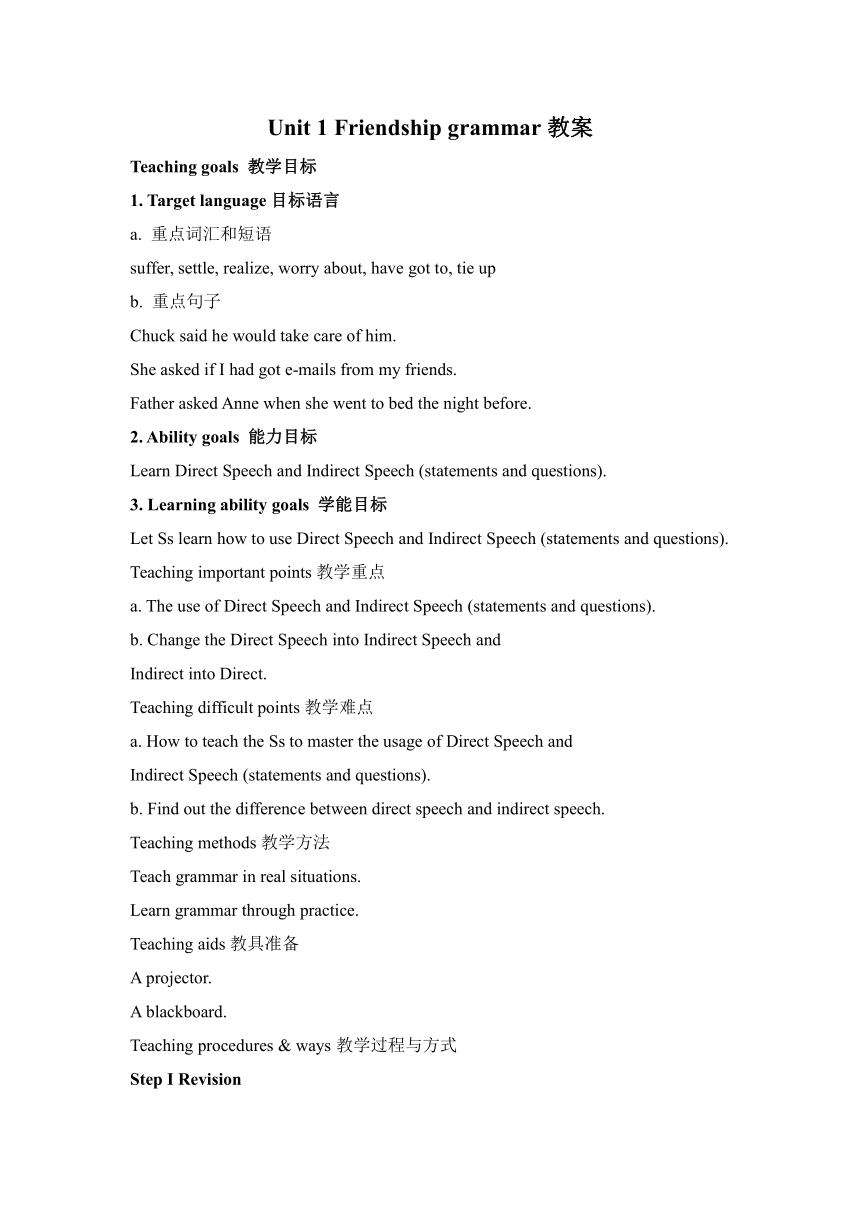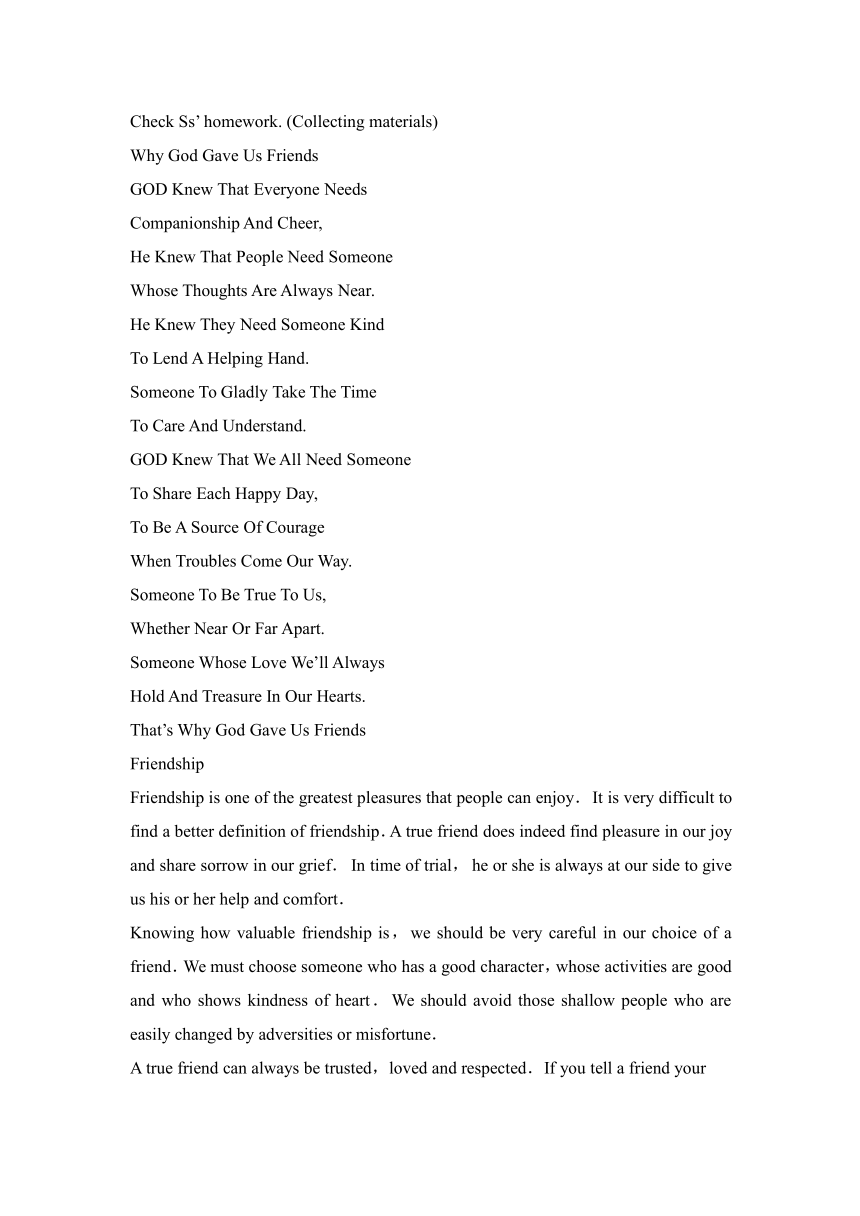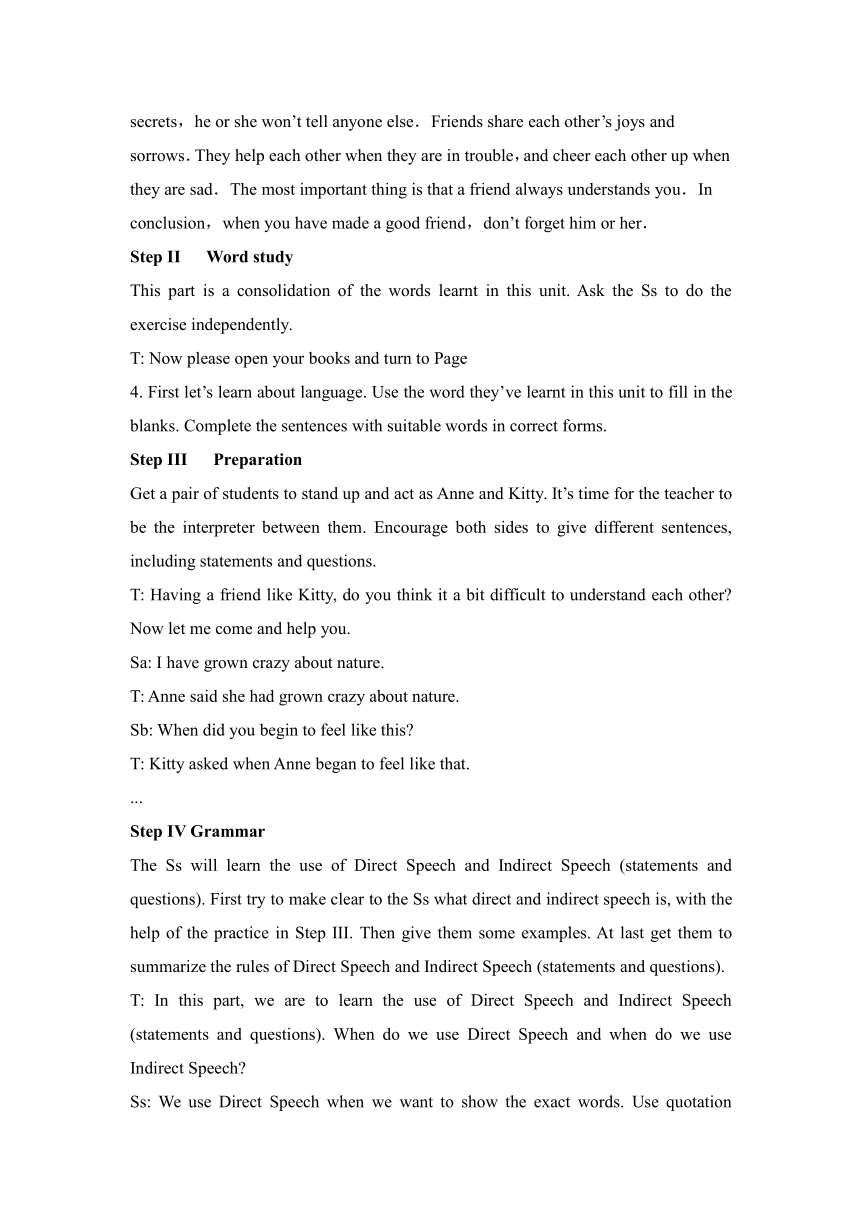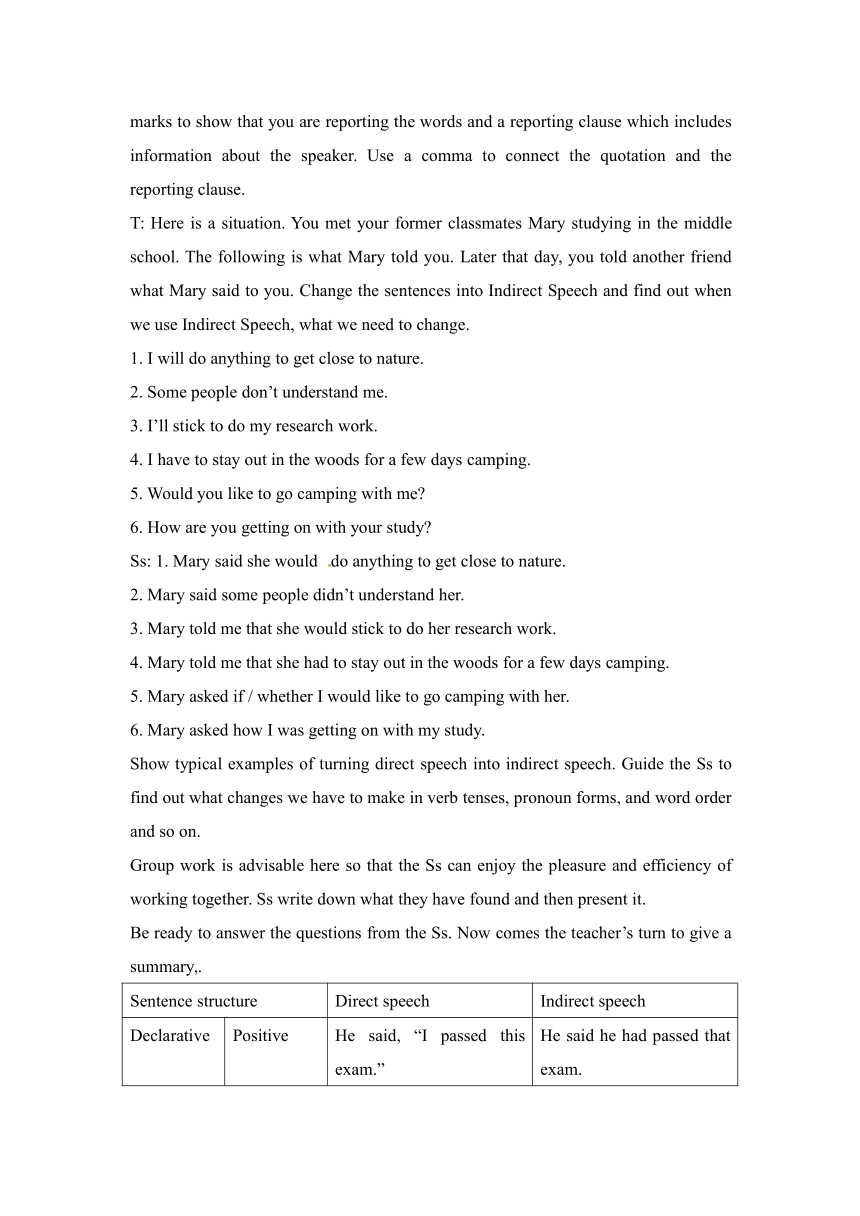人教版必修一Unit 1 Friendship grammar教案
文档属性
| 名称 | 人教版必修一Unit 1 Friendship grammar教案 |

|
|
| 格式 | docx | ||
| 文件大小 | 20.6KB | ||
| 资源类型 | 教案 | ||
| 版本资源 | 人教版(新课程标准) | ||
| 科目 | 英语 | ||
| 更新时间 | 2020-11-28 19:09:54 | ||
图片预览




文档简介
Unit
1
Friendship
grammar教案
Teaching
goals
教学目标
1.
Target
language目标语言
a.
重点词汇和短语
suffer,
settle,
realize,
worry
about,
have
got
to,
tie
up
b.
重点句子
Chuck
said
he
would
take
care
of
him.
She
asked
if
I
had
got
e-mails
from
my
friends.
Father
asked
Anne
when
she
went
to
bed
the
night
before.
2.
Ability
goals
能力目标
Learn
Direct
Speech
and
Indirect
Speech
(statements
and
questions).
3.
Learning
ability
goals
学能目标
Let
Ss
learn
how
to
use
Direct
Speech
and
Indirect
Speech
(statements
and
questions).
Teaching
important
points教学重点
a.
The
use
of
Direct
Speech
and
Indirect
Speech
(statements
and
questions).
b.
Change
the
Direct
Speech
into
Indirect
Speech
and
Indirect
into
Direct.
Teaching
difficult
points教学难点
a.
How
to
teach
the
Ss
to
master
the
usage
of
Direct
Speech
and
Indirect
Speech
(statements
and
questions).
b.
Find
out
the
difference
between
direct
speech
and
indirect
speech.
Teaching
methods教学方法
Teach
grammar
in
real
situations.
Learn
grammar
through
practice.
Teaching
aids教具准备
A
projector.
A
blackboard.
Teaching
procedures
&
ways教学过程与方式
Step
I
Revision
Check
Ss’
homework.
(Collecting
materials)
Why
God
Gave
Us
Friends
GOD
Knew
That
Everyone
Needs
Companionship
And
Cheer,
He
Knew
That
People
Need
Someone
Whose
Thoughts
Are
Always
Near.
He
Knew
They
Need
Someone
Kind
To
Lend
A
Helping
Hand.[]
Someone
To
Gladly
Take
The
Time
To
Care
And
Understand.
GOD
Knew
That
We
All
Need
Someone
To
Share
Each
Happy
Day,
To
Be
A
Source
Of
Courage
When
Troubles
Come
Our
Way.
Someone
To
Be
True
To
Us,
Whether
Near
Or
Far
Apart.
Someone
Whose
Love
We’ll
Always
Hold
And
Treasure
In
Our
Hearts.
That’s
Why
God
Gave
Us
Friends
Friendship
Friendship
is
one
of
the
greatest
pleasures
that
people
can
enjoy.
It
is
very
difficult
to
find
a
better
definition
of
friendship.A
true
friend
does
indeed
find
pleasure
in
our
joy
and
share
sorrow
in
our
grief.
In
time
of
trial,
he
or
she
is
always
at
our
side
to
give
us
his
or
her
help
and
comfort.
Knowing
how
valuable
friendship
is,we
should
be
very
careful
in
our
choice
of
a
friend.We
must
choose
someone
who
has
a
good
character,whose
activities
are
good
and
who
shows
kindness
of
heart.We
should
avoid
those
shallow
people
who
are
easily
changed
by
adversities
or
misfortune.
A
true
friend
can
always
be
trusted,loved
and
respected.If
you
tell
a
friend
your
secrets,he
or
she
won’t
tell
anyone
else.Friends
share
each
other’s
joys
and
sorrows.They
help
each
other
when
they
are
in
trouble,and
cheer
each
other
up
when
they
are
sad.The
most
important
thing
is
that
a
friend
always
understands
you.In
conclusion,when
you
have
made
a
good
friend,don’t
forget
him
or
her.
Step
II
Word
study
This
part
is
a
consolidation
of
the
words
learnt
in
this
unit.
Ask
the
Ss
to
do
the
exercise
independently.
T:
Now
please
open
your
books
and
turn
to
Page
4.
First
let’s
learn
about
language.
Use
the
word
they’ve
learnt
in
this
unit
to
fill
in
the
blanks.
Complete
the
sentences
with
suitable
words
in
correct
forms.
Step
III
Preparation
Get
a
pair
of
students
to
stand
up
and
act
as
Anne
and
Kitty.
It’s
time
for
the
teacher
to
be
the
interpreter
between
them.
Encourage
both
sides
to
give
different
sentences,
including
statements
and
questions.
T:
Having
a
friend
like
Kitty,
do
you
think
it
a
bit
difficult
to
understand
each
other?
Now
let
me
come
and
help
you.
Sa:
I
have
grown
crazy
about
nature.
T:
Anne
said
she
had
grown
crazy
about
nature.
Sb:
When
did
you
begin
to
feel
like
this?
T:
Kitty
asked
when
Anne
began
to
feel
like
that.
...
Step
IV
Grammar
The
Ss
will
learn
the
use
of
Direct
Speech
and
Indirect
Speech
(statements
and
questions).
First
try
to
make
clear
to
the
Ss
what
direct
and
indirect
speech
is,
with
the
help
of
the
practice
in
Step
III.
Then
give
them
some
examples.
At
last
get
them
to
summarize
the
rules
of
Direct
Speech
and
Indirect
Speech
(statements
and
questions).
T:
In
this
part,
we
are
to
learn
the
use
of
Direct
Speech
and
Indirect
Speech
(statements
and
questions).
When
do
we
use
Direct
Speech
and
when
do
we
use
Indirect
Speech?
Ss:
We
use
Direct
Speech
when
we
want
to
show
the
exact
words.
Use
quotation
marks
to
show
that
you
are
reporting
the
words
and
a
reporting
clause
which
includes
information
about
the
speaker.
Use
a
comma
to
connect
the
quotation
and
the
reporting
clause.
T:
Here
is
a
situation.
You
met
your
former
classmates
Mary
studying
in
the
middle
school.
The
following
is
what
Mary
told
you.
Later
that
day,
you
told
another
friend
what
Mary
said
to
you.
Change
the
sentences
into
Indirect
Speech
and
find
out
when
we
use
Indirect
Speech,
what
we
need
to
change.
1.
I
will
do
anything
to
get
close
to
nature.
2.
Some
people
don’t
understand
me.
3.
I’ll
stick
to
do
my
research
work.
4.
I
have
to
stay
out
in
the
woods
for
a
few
days
camping.
5.
Would
you
like
to
go
camping
with
me?
6.
How
are
you
getting
on
with
your
study?
Ss:
1.
Mary
said
she
would
do
anything
to
get
close
to
nature.
2.
Mary
said
some
people
didn’t
understand
her.
3.
Mary
told
me
that
she
would
stick
to
do
her
research
work.
4.
Mary
told
me
that
she
had
to
stay
out
in
the
woods
for
a
few
days
camping.
5.
Mary
asked
if
/
whether
I
would
like
to
go
camping
with
her.
6.
Mary
asked
how
I
was
getting
on
with
my
study.
Show
typical
examples
of
turning
direct
speech
into
indirect
speech.
Guide
the
Ss
to
find
out
what
changes
we
have
to
make
in
verb
tenses,
pronoun
forms,
and
word
order
and
so
on.
Group
work
is
advisable
here
so
that
the
Ss
can
enjoy
the
pleasure
and
efficiency
of
working
together.
Ss
write
down
what
they
have
found
and
then
present
it.
Be
ready
to
answer
the
questions
from
the
Ss.
Now
comes
the
teacher’s
turn
to
give
a
summary,.
Sentence
structure
Direct
speech
Indirect
speech
Declarative
Positive
He
said,
“I
passed
this
exam.”
He
said
he
had
passed
that
exam.
Negative
Lucy
said,
“I
can’t
finish
reading
the
book
this
afternoon”
Lucy
told
me
that
she
couldn’t
finish
reading
the
book
that
afternoon
Interrogative
“Are
you
going
to
mail
this
gift?”
Tom
asked
Bob.
Tom
asked
Bob
if
he
was
going
to
mail
that
gift.
Special
Interrogative
“How
can
I
solve
the
problem?”
Jane
asked
me.
Jane
asked
me
how
she
could
solve
the
problem.
Imperative
“Don’t
talk
in
class”
said
Mr.
Green.
Mr.
Green
ordered
me
not
to
talk
in
class.
Exclamatory
“How
silly
the
boy
is!”
Peter
exclaimed.
Peter
told
me
how
silly
the
boy
was.
T:
Now
please
find
out
what
changes
we
have
to
make
in
verb
tenses,
pronoun
forms,
word
order
and
so
on
in
groups
of
4.
Ss
write
down
what
they
have
found
and
then
present
it.
T:
Now
let’s
summarize
the
rules
of
Direct
Speech
and
Indirect
Speech
Direct
Speech
Indirect
Speech
Sentence
structure
Declarative
Say
/tell
sb.
(that)
+clause
Interrogative
Ask/
wonder
whether/if
+
statement
order
Special
Interrogative
Ask/
wonder
+
wh-word
+
statement
order
Interrogative
Ask/tell
/
order
sb.
(not
)
to
do
Explanative
Tell
sb.
what
/
how
+
statement
order
Tense
Present
Past
Past
past
perfect
Present
perfect
Past
perfect
Past
perfect
Past
perfect
Present
continuous
Past
continuous
Future
Past
future
Pronoun
First
person
Third
person
Second
person
First
or
third
person
this
That
These
Those
Adverbial
of
time
Now
Then
Today
That
day
Yesterday
The
day
before
This
week/month
That
week/month
Last
week/month
The
week/month
before
Three
days
ago
Three
days
before
Tomorrow
The
next
day
/
the
following
day
Adverbial
of
place
here
there
This
place
That
place
These
places
Those
places
Verb
Come
Go
bring
Take
There
are
some
cases
in
which
we
don’t
need
to
change
the
tense.
Case
Direct
speech
Indirect
speech
a
truth
He
said,
“The
earth
goes
around
the
sun.”
He
said
that
the
earth
goes
around
the
sun.
timetable
He
said,
“The
plane
takes
off
at
6:30
a.m.”
He
said
that
the
plane
takes
off
at
6:30a.
m.
a
saying
a
proverb
a
quotation
He
said,
“Where
there
is
a
will,
there
is
a
way.”
He
said
that
where
there
is
a
will,
there
is
a
way.
an
adverbial
indicting
the
past:
Mr.
Wang
said,
“I
was
born
in
September,
1972.”
Mr.
Wang
said,“he
was
born
in
September,
1972.”
Step
V
Practice
For
Ex
1,
get
the
Ss
to
look
at
the
sentences
carefully
in
pairs
in
order
to
find
out
the
difference
between
direct
speech
and
indirect
speech.
Guide
the
Ss
to
find
out
the
changes
in
pronoun
forms,
word
order,
adverbials
and
so
on,
especially
the
verb
tenses,
the
underline
parts.
Ask
the
Ss
to
pay
attention
to
the
reporting
clause.
For
Ex
2,
ask
the
Ss
to
do
it
by
themselves,
then
check
the
answers
by
asking
some
Ss
to
read
aloud
their
answers.
T:
Please
look
at
the
sentences
carefully
in
pairs
in
order
to
find
out
the
difference
between
direct
speech
and
indirect
speech
in
pronoun
forms,
word
order,
adverbials
and
so
on,
especially
the
verb
tenses,
the
underline
parts.
The
Ss
are
finding
out
the
difference
and
changes.
T:
Now,
you’ve
known
the
difference
and
the
changes
in
pronoun
forms,
word
order,
adverbials
and
so
on,
especially
the
verb
tenses.
How
about
the
reporting
clause?
S1:
The
reporting
clause
may
come
before,
within,
or
after
the
direct
speech.
When
the
reporting
clause
comes
after
the
direct
speech,
the
order
of
the
subject
and
the
verb
may
be
changed.
E.g.
Jane
said
/
said
Jane.
This
typically
happens
when
the
reporting
clause
is
within
the
reported
speech
and
the
subject
is
not
a
pronoun.
S2:
Use
a
comma
to
connect
the
direct
speech
and
the
reporting
clause.
T:
Quite
right.
Now
let’s
deal
with
Ex2,
change
the
direct
speech
into
indirect
speech
and
indirect
into
direct,
paying
attention
to
the
difference
and
changes
in
pronoun
forms,
word
order,
adverbials
and
so
on,
especially
the
verb
tenses.
Please
do
it
by
yourselves.
The
Ss
are
practicing
Ex
2.
T:
OK,
let’s
check
the
answers
by
asking
some
Ss
to
read
aloud
their
answers.
Ss:
...
Step
VI
Homework
1.
Practice
of
WB
(P42.1
&&P
43.2)
2.
Ask
the
Ss
to
think
out
different
ways
to
solve
the
problems
about
making
friends,
preparing
the
materials
about
the
debate.
Get
the
Ss
to
know
the
problem
was
that
Anne
had
made
a
friend
in
the
hiding
place
—
the
son
of
another
family
hiding
with
them,
but
her
father
was
not
happy
about
this.
The
topic
is:
How
do
you
help
to
solve
the
problem
between
Anne
and
her
father.
Do
you
agree
with
Anne
or
her
father?
Use
specific
reasons
to
support
your
solutions.
1
Friendship
grammar教案
Teaching
goals
教学目标
1.
Target
language目标语言
a.
重点词汇和短语
suffer,
settle,
realize,
worry
about,
have
got
to,
tie
up
b.
重点句子
Chuck
said
he
would
take
care
of
him.
She
asked
if
I
had
got
e-mails
from
my
friends.
Father
asked
Anne
when
she
went
to
bed
the
night
before.
2.
Ability
goals
能力目标
Learn
Direct
Speech
and
Indirect
Speech
(statements
and
questions).
3.
Learning
ability
goals
学能目标
Let
Ss
learn
how
to
use
Direct
Speech
and
Indirect
Speech
(statements
and
questions).
Teaching
important
points教学重点
a.
The
use
of
Direct
Speech
and
Indirect
Speech
(statements
and
questions).
b.
Change
the
Direct
Speech
into
Indirect
Speech
and
Indirect
into
Direct.
Teaching
difficult
points教学难点
a.
How
to
teach
the
Ss
to
master
the
usage
of
Direct
Speech
and
Indirect
Speech
(statements
and
questions).
b.
Find
out
the
difference
between
direct
speech
and
indirect
speech.
Teaching
methods教学方法
Teach
grammar
in
real
situations.
Learn
grammar
through
practice.
Teaching
aids教具准备
A
projector.
A
blackboard.
Teaching
procedures
&
ways教学过程与方式
Step
I
Revision
Check
Ss’
homework.
(Collecting
materials)
Why
God
Gave
Us
Friends
GOD
Knew
That
Everyone
Needs
Companionship
And
Cheer,
He
Knew
That
People
Need
Someone
Whose
Thoughts
Are
Always
Near.
He
Knew
They
Need
Someone
Kind
To
Lend
A
Helping
Hand.[]
Someone
To
Gladly
Take
The
Time
To
Care
And
Understand.
GOD
Knew
That
We
All
Need
Someone
To
Share
Each
Happy
Day,
To
Be
A
Source
Of
Courage
When
Troubles
Come
Our
Way.
Someone
To
Be
True
To
Us,
Whether
Near
Or
Far
Apart.
Someone
Whose
Love
We’ll
Always
Hold
And
Treasure
In
Our
Hearts.
That’s
Why
God
Gave
Us
Friends
Friendship
Friendship
is
one
of
the
greatest
pleasures
that
people
can
enjoy.
It
is
very
difficult
to
find
a
better
definition
of
friendship.A
true
friend
does
indeed
find
pleasure
in
our
joy
and
share
sorrow
in
our
grief.
In
time
of
trial,
he
or
she
is
always
at
our
side
to
give
us
his
or
her
help
and
comfort.
Knowing
how
valuable
friendship
is,we
should
be
very
careful
in
our
choice
of
a
friend.We
must
choose
someone
who
has
a
good
character,whose
activities
are
good
and
who
shows
kindness
of
heart.We
should
avoid
those
shallow
people
who
are
easily
changed
by
adversities
or
misfortune.
A
true
friend
can
always
be
trusted,loved
and
respected.If
you
tell
a
friend
your
secrets,he
or
she
won’t
tell
anyone
else.Friends
share
each
other’s
joys
and
sorrows.They
help
each
other
when
they
are
in
trouble,and
cheer
each
other
up
when
they
are
sad.The
most
important
thing
is
that
a
friend
always
understands
you.In
conclusion,when
you
have
made
a
good
friend,don’t
forget
him
or
her.
Step
II
Word
study
This
part
is
a
consolidation
of
the
words
learnt
in
this
unit.
Ask
the
Ss
to
do
the
exercise
independently.
T:
Now
please
open
your
books
and
turn
to
Page
4.
First
let’s
learn
about
language.
Use
the
word
they’ve
learnt
in
this
unit
to
fill
in
the
blanks.
Complete
the
sentences
with
suitable
words
in
correct
forms.
Step
III
Preparation
Get
a
pair
of
students
to
stand
up
and
act
as
Anne
and
Kitty.
It’s
time
for
the
teacher
to
be
the
interpreter
between
them.
Encourage
both
sides
to
give
different
sentences,
including
statements
and
questions.
T:
Having
a
friend
like
Kitty,
do
you
think
it
a
bit
difficult
to
understand
each
other?
Now
let
me
come
and
help
you.
Sa:
I
have
grown
crazy
about
nature.
T:
Anne
said
she
had
grown
crazy
about
nature.
Sb:
When
did
you
begin
to
feel
like
this?
T:
Kitty
asked
when
Anne
began
to
feel
like
that.
...
Step
IV
Grammar
The
Ss
will
learn
the
use
of
Direct
Speech
and
Indirect
Speech
(statements
and
questions).
First
try
to
make
clear
to
the
Ss
what
direct
and
indirect
speech
is,
with
the
help
of
the
practice
in
Step
III.
Then
give
them
some
examples.
At
last
get
them
to
summarize
the
rules
of
Direct
Speech
and
Indirect
Speech
(statements
and
questions).
T:
In
this
part,
we
are
to
learn
the
use
of
Direct
Speech
and
Indirect
Speech
(statements
and
questions).
When
do
we
use
Direct
Speech
and
when
do
we
use
Indirect
Speech?
Ss:
We
use
Direct
Speech
when
we
want
to
show
the
exact
words.
Use
quotation
marks
to
show
that
you
are
reporting
the
words
and
a
reporting
clause
which
includes
information
about
the
speaker.
Use
a
comma
to
connect
the
quotation
and
the
reporting
clause.
T:
Here
is
a
situation.
You
met
your
former
classmates
Mary
studying
in
the
middle
school.
The
following
is
what
Mary
told
you.
Later
that
day,
you
told
another
friend
what
Mary
said
to
you.
Change
the
sentences
into
Indirect
Speech
and
find
out
when
we
use
Indirect
Speech,
what
we
need
to
change.
1.
I
will
do
anything
to
get
close
to
nature.
2.
Some
people
don’t
understand
me.
3.
I’ll
stick
to
do
my
research
work.
4.
I
have
to
stay
out
in
the
woods
for
a
few
days
camping.
5.
Would
you
like
to
go
camping
with
me?
6.
How
are
you
getting
on
with
your
study?
Ss:
1.
Mary
said
she
would
do
anything
to
get
close
to
nature.
2.
Mary
said
some
people
didn’t
understand
her.
3.
Mary
told
me
that
she
would
stick
to
do
her
research
work.
4.
Mary
told
me
that
she
had
to
stay
out
in
the
woods
for
a
few
days
camping.
5.
Mary
asked
if
/
whether
I
would
like
to
go
camping
with
her.
6.
Mary
asked
how
I
was
getting
on
with
my
study.
Show
typical
examples
of
turning
direct
speech
into
indirect
speech.
Guide
the
Ss
to
find
out
what
changes
we
have
to
make
in
verb
tenses,
pronoun
forms,
and
word
order
and
so
on.
Group
work
is
advisable
here
so
that
the
Ss
can
enjoy
the
pleasure
and
efficiency
of
working
together.
Ss
write
down
what
they
have
found
and
then
present
it.
Be
ready
to
answer
the
questions
from
the
Ss.
Now
comes
the
teacher’s
turn
to
give
a
summary,.
Sentence
structure
Direct
speech
Indirect
speech
Declarative
Positive
He
said,
“I
passed
this
exam.”
He
said
he
had
passed
that
exam.
Negative
Lucy
said,
“I
can’t
finish
reading
the
book
this
afternoon”
Lucy
told
me
that
she
couldn’t
finish
reading
the
book
that
afternoon
Interrogative
“Are
you
going
to
this
gift?”
Tom
asked
Bob.
Tom
asked
Bob
if
he
was
going
to
that
gift.
Special
Interrogative
“How
can
I
solve
the
problem?”
Jane
asked
me.
Jane
asked
me
how
she
could
solve
the
problem.
Imperative
“Don’t
talk
in
class”
said
Mr.
Green.
Mr.
Green
ordered
me
not
to
talk
in
class.
Exclamatory
“How
silly
the
boy
is!”
Peter
exclaimed.
Peter
told
me
how
silly
the
boy
was.
T:
Now
please
find
out
what
changes
we
have
to
make
in
verb
tenses,
pronoun
forms,
word
order
and
so
on
in
groups
of
4.
Ss
write
down
what
they
have
found
and
then
present
it.
T:
Now
let’s
summarize
the
rules
of
Direct
Speech
and
Indirect
Speech
Direct
Speech
Indirect
Speech
Sentence
structure
Declarative
Say
/tell
sb.
(that)
+clause
Interrogative
Ask/
wonder
whether/if
+
statement
order
Special
Interrogative
Ask/
wonder
+
wh-word
+
statement
order
Interrogative
Ask/tell
/
order
sb.
(not
)
to
do
Explanative
Tell
sb.
what
/
how
+
statement
order
Tense
Present
Past
Past
past
perfect
Present
perfect
Past
perfect
Past
perfect
Past
perfect
Present
continuous
Past
continuous
Future
Past
future
Pronoun
First
person
Third
person
Second
person
First
or
third
person
this
That
These
Those
Adverbial
of
time
Now
Then
Today
That
day
Yesterday
The
day
before
This
week/month
That
week/month
Last
week/month
The
week/month
before
Three
days
ago
Three
days
before
Tomorrow
The
next
day
/
the
following
day
Adverbial
of
place
here
there
This
place
That
place
These
places
Those
places
Verb
Come
Go
bring
Take
There
are
some
cases
in
which
we
don’t
need
to
change
the
tense.
Case
Direct
speech
Indirect
speech
a
truth
He
said,
“The
earth
goes
around
the
sun.”
He
said
that
the
earth
goes
around
the
sun.
timetable
He
said,
“The
plane
takes
off
at
6:30
a.m.”
He
said
that
the
plane
takes
off
at
6:30a.
m.
a
saying
a
proverb
a
quotation
He
said,
“Where
there
is
a
will,
there
is
a
way.”
He
said
that
where
there
is
a
will,
there
is
a
way.
an
adverbial
indicting
the
past:
Mr.
Wang
said,
“I
was
born
in
September,
1972.”
Mr.
Wang
said,“he
was
born
in
September,
1972.”
Step
V
Practice
For
Ex
1,
get
the
Ss
to
look
at
the
sentences
carefully
in
pairs
in
order
to
find
out
the
difference
between
direct
speech
and
indirect
speech.
Guide
the
Ss
to
find
out
the
changes
in
pronoun
forms,
word
order,
adverbials
and
so
on,
especially
the
verb
tenses,
the
underline
parts.
Ask
the
Ss
to
pay
attention
to
the
reporting
clause.
For
Ex
2,
ask
the
Ss
to
do
it
by
themselves,
then
check
the
answers
by
asking
some
Ss
to
read
aloud
their
answers.
T:
Please
look
at
the
sentences
carefully
in
pairs
in
order
to
find
out
the
difference
between
direct
speech
and
indirect
speech
in
pronoun
forms,
word
order,
adverbials
and
so
on,
especially
the
verb
tenses,
the
underline
parts.
The
Ss
are
finding
out
the
difference
and
changes.
T:
Now,
you’ve
known
the
difference
and
the
changes
in
pronoun
forms,
word
order,
adverbials
and
so
on,
especially
the
verb
tenses.
How
about
the
reporting
clause?
S1:
The
reporting
clause
may
come
before,
within,
or
after
the
direct
speech.
When
the
reporting
clause
comes
after
the
direct
speech,
the
order
of
the
subject
and
the
verb
may
be
changed.
E.g.
Jane
said
/
said
Jane.
This
typically
happens
when
the
reporting
clause
is
within
the
reported
speech
and
the
subject
is
not
a
pronoun.
S2:
Use
a
comma
to
connect
the
direct
speech
and
the
reporting
clause.
T:
Quite
right.
Now
let’s
deal
with
Ex2,
change
the
direct
speech
into
indirect
speech
and
indirect
into
direct,
paying
attention
to
the
difference
and
changes
in
pronoun
forms,
word
order,
adverbials
and
so
on,
especially
the
verb
tenses.
Please
do
it
by
yourselves.
The
Ss
are
practicing
Ex
2.
T:
OK,
let’s
check
the
answers
by
asking
some
Ss
to
read
aloud
their
answers.
Ss:
...
Step
VI
Homework
1.
Practice
of
WB
(P42.1
&&P
43.2)
2.
Ask
the
Ss
to
think
out
different
ways
to
solve
the
problems
about
making
friends,
preparing
the
materials
about
the
debate.
Get
the
Ss
to
know
the
problem
was
that
Anne
had
made
a
friend
in
the
hiding
place
—
the
son
of
another
family
hiding
with
them,
but
her
father
was
not
happy
about
this.
The
topic
is:
How
do
you
help
to
solve
the
problem
between
Anne
and
her
father.
Do
you
agree
with
Anne
or
her
father?
Use
specific
reasons
to
support
your
solutions.
